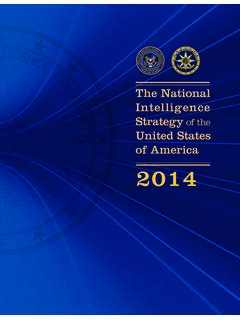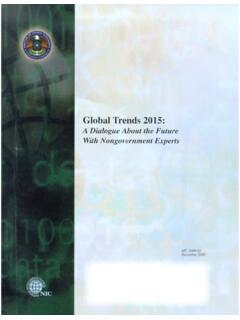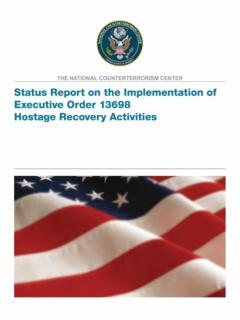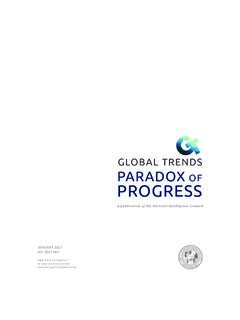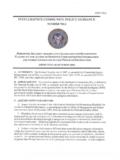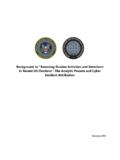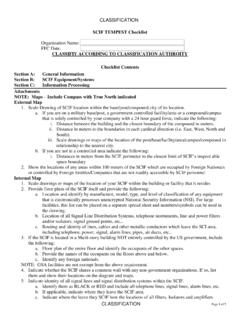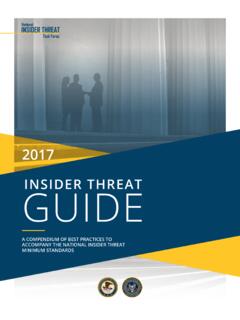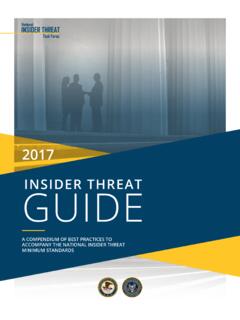Transcription of Intelligence Community Information Environment (IC IE ...
1 Intelligence Community Information Environment (IC IE). Data Strategy 2017-2021. TABLE OF CONTENTS. ii MESSAGE FROM THE DNI. iii MESSAGE FROM THE IC CDO AND IC ISSE. 1 introduction . 2 VISION, MISSION, OPERATING PRINCIPLES. 3 strategic GOALS. 4 Goal 1: Develop and Institutionalize a strategic Data Framework Across the Multi- fabric IC Information Environment 6 Goal 2: Ensure Data is Appropriately Protected, Shared, and Handled Across All Fabrics 7 Goal 3: Create, Resource, and Leverage Secured, Scalable and Shared Data Services that Meet the IC's Needs for Variety, Velocity, Volume, and Veracity 8 Goal 4: Champion a Culture that Encourages and Rewards Data-Centric Behaviors that Effectively Balance Sharing and Safeguarding 11 THE WAY AHEAD FOR strategic IMPLEMENTATION. IC IE DATA STRATEGY 2017-2021 i MESSAGE FROM THE DNI. ii IC IE DATA STRATEGY 2017-2021. MESSAGE FROM THE IC CDO AND IC ISSE. In today's big data world, the Intelligence Community is acquiring, collecting, creating, and disposing of more data1 than ever.
2 For this Information to be useful, we must rely less on our historic approach of using bilateral sharing agreements that constrain its use along organizational boundaries, and more on leveraging data services as the means to enforce all data handling and usage requirements for authorized IC personnel. We must no longer replicate data for different missions or disparate systems constrained by individual programs of record, but take advantage of our big data platforms to leverage all data that will help us gain insights. This strategy describes a new approach to managing Data as an IC Asset that is, maximizing use of data that may be relevant to one or more IC element for Intelligence purposes. Interdisciplinary use of the IC's vast collection of Intelligence Information is critical to produce timely, accurate, thorough, and integrated Intelligence positions. To do this, we will free the data . by removing its current dependencies on IC element applications, systems, and databases, thus allowing it to be cataloged, self-described, and discoverable by automated means.
3 Just as important, we will ensure that we apply safeguards and applicable legal and policy requirements for handling, use, and dissemination consistently across the enterprise. This strategy document describes the overarching vision, mission, and objectives to make the right data available to the right people, at the right time and, in the right form to enable data- and analytic-driven decisions for our Intelligence mission. This IC Information Environment (IC IE) 2. Data Strategy is grounded in public and private sector best practices and the principles presented by IC Directive (ICD) 501, Discovery and Dissemination or Retrieval of Information within the IC;. ICD 121, Managing the IC Information Environment ; and the National Intelligence Strategy. The goals and objectives described in the strategy will be used to guide the creation of implementation plans. The IC CDO and the IC ISSE partner with IC elements to realize an IC-wide strategic direction is set forth for IC enterprise data and Information sharing.
4 Through the IC CDO Council and the Information Sharing Steering Committee, we will oversee and prioritize implementation of the principles described in this IC IE Data Strategy. Stephen D. Prosser James A. Smith Intelligence Community Chief Data Officer Intelligence Community Information Sharing and Safeguarding Executive 1 Within this document, the term, data means data and Information categorized as either mission or business. 2 Within this document, the IC IE refers to individuals, organizations and Information Technology capabilities that collect, process or share Sensitive Compartmented Information , or that, regardless of classification, are operated by the IC. IC IE DATA STRATEGY 2017-2021 iii The proposals and improvements in this document will materially improve the Intelligence value extracted from all the data we acquire, create, collect, process, disseminate, use, store, and archive. iv IC IE DATA STRATEGY 2017-2021. introduction . Informed decisions based on accurate, timely, insightful, and objective analysis are critical to provide the front-line of defense against threats to the and its global partners.
5 The IC is a critical component of the national security structure that provides the Information necessary to address those threats. The intent of this IC IE Data Strategy is to guide the IC toward a common, more secure, and more integrated enterprise by leveraging the vision and framework of the IC IE. to operationalize a data-centric Community . The Strategy sets out goals and objectives for data- centricity that call upon IC elements to place mission and business data at the center of every plan to drive mission success. The goal of the IC IE Data Strategy is to ensure the right data gets to the right people at the right time in the right form. Today's challenges require new approaches to IC operations and mission support. Our nation continues to confront challenges posed by globalization, the blurring of foreign and domestic threats, and demand for speed-of-decision required by the overlap of Intelligence and operations. Evolving cyber threats have also focused attention on the need to protect personal identifiable Information , regardless of source, from unauthorized users.
6 The challenges of delivering data must be addressed in a dynamic Environment characterized by differing approaches to both formal and informal interagency collaboration, and different authorities to acquire, collect, curate, retain, and share data. These processes operate against a backdrop of unabated growth in Information . A majority of IC data is also tightly coupled with the data management and mission-analytic capabilities of IC element-specific systems. Ultimately, achieving data-centricity will require separation of the data from these applications. ICD 501 directs that IC elements have the responsibility to provide and authorized IC personnel have the responsibility to discover and request data that can contribute to their assigned mission. This sharing imperative also applies to law enforcement, the rest of government, and our international partners. To instill these disciplines in the IC, we must foster a culture where our people maximize the value of data across the IC, and have the tools and abilities to effectively use it.
7 In a data-driven culture, data is the concern of every employee, not just data architects, scientists, and providers; it further requires placing data sharing at the center of all forms of decision-making. Expanding the overall value of IC data that may be relevant to one or more IC elements for Intelligence purposes requires a common operating model that describes and incentivizes the adoption of rules for acquisition, sharing, discovery, access, and use. A secure, fully data-centric Environment will separate data from applications, and make data available to a broad range of tools and analytics within and across security domains for enrichment and discovery. The Environment must embrace a more disciplined approach to Intelligence integration by ensuring that data is sharable, discoverable, accessible, retrievable, and protected. Finally, the IC needs to evolve its governance process to manage policy, standards, and prioritization of shared data management resources. Rather than individual sharing agreements, IC elements should utilize multilateral arrangements where appropriate, and rely more on data services as a means to enforce all of the legal and policy requirements governing access, use, dissemination, or retention of Information .
8 Intelligence integration is more important than ever, and establishing an IC framework for realizing the principle of Data as an IC Asset will enable a full range of data and mission uses. IC IE DATA STRATEGY 2017-2021 1. VISION: The right data to the right people at the right time. MISSION: Make IC data discoverable, accessible, and usable at the speed of mission. OPERATING PRINCIPLES: Mission First Make decisions based on Intelligence mission needs. Leadership Provide strategic leadership across the IC. Partnership Achieve unity of effort through teamwork, collaboration, and transparency. Innovation Leverage technology to increase effectiveness and drive efficiency. Achievement Deliver an integrated, secure enterprise to satisfy the highest mission priorities. 2 IC IE DATA STRATEGY 2017-2021. strategic GOALS. Develop and institutionalize a strategic data framework across the multi-fabric IC. Information Environment Free data so it can be discovered, accessed, linked, and used independently by mission applications and common IC services.
9 Align and strengthen policies and practices toward a shared vision to leverage Community investments to increase standardization, efficiency and interoperability. Ensure data is appropriately protected, shared, and handled across all fabrics Promote a common approach for security and privacy that advances secure, cross domain sharing of data. Create and resource scalable shared data services that meet the IC's needs for variety, velocity, volume, and veracity Provide leadership on strategic needs for shared data services throughout the data life cycle. Develop integrated governance and management processes that promote standards-based services that are technical enablers for new and innovative methods for using data to accelerate the pace and quality of analytic insight. Free our data scientists to do data science, not data wrangling. Foster a culture that champions, encourages, and rewards data-centric behaviors that effectively balance sharing and safeguarding Advocate for Information sharing across the IC and reduce unnecessary barriers that impede discovery, access, trust, and usability.
10 Promote effective data stewardship by shaping education, awareness, training, and development to reinforce data-centric behavior. Strengthen and leverage industry, academia, and government partnerships to accelerate innovation in tradecraft to meet mission needs. IC IE DATA STRATEGY 2017-2021 3. strategic GOAL. Develop and institutionalize a strategic Data Framework across the multi-fabric IC. Information Environment The reliance of IC element analysts and users on incomplete or constrained sets of data precludes the discovery of contrary, supportive, or enhanced Information held by others. This limits fully- informed analysis and decision-making. Historically, IC elements have protected their data by isolating it in silos, and managing it for IC element-specific missions. Freed data can be discovered, accessed, linked, and used independently by mission applications and common IC. services that leverage multiple databases and analytic environments. Removing unnecessary barriers to sharing will allow the IC to realize the full potential of the data it acquires, collects, or creates.
